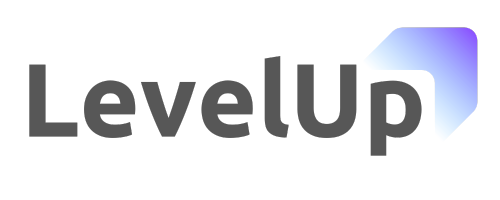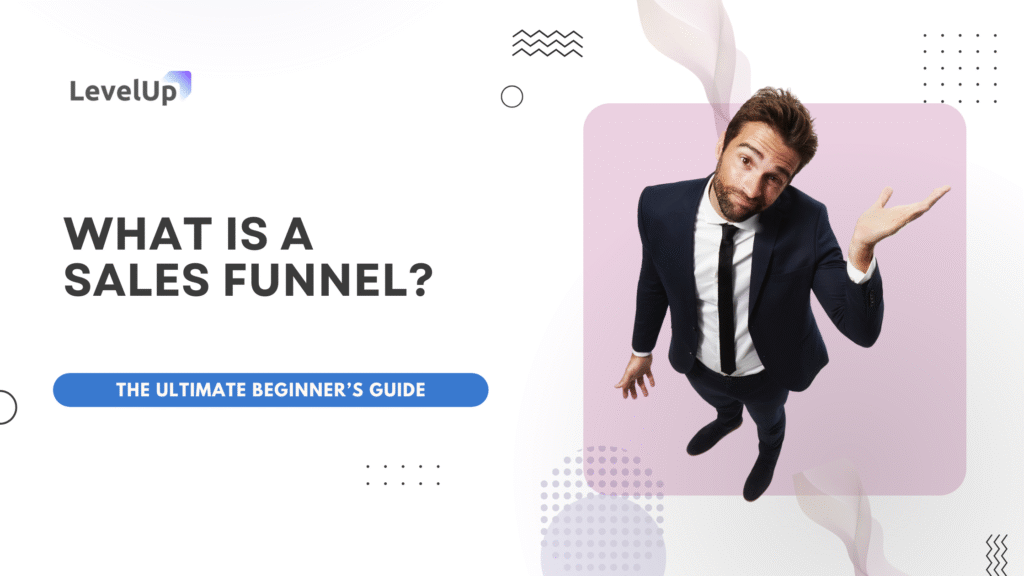Picture this: You’re at a networking event last month, and I overhear this conversation between two entrepreneurs. One guy says, “My marketing’s bringing in tons of leads, but I’m barely closing any sales.” Sound familiar? Here’s the thing – he had no sales funnel. And honestly, I see this mistake way too often. A sales funnel is essentially a step-by-step process that guides potential customers from first discovering your business to actually buying from you. Think of it like a roadmap that shows exactly where each prospect is in their buying journey, helping you nurture them with the right message at the right time. In this post, I’m going to walk you through everything you need to know about sales funnels – from the basic concept to building one that actually converts. We’ll cover the five core stages, common mistakes I’ve seen (and made myself), and practical strategies you can implement immediately. Whether you’re a sales professional looking to streamline your process or an entrepreneur trying to turn more leads into customers, understanding sales funnels will literally transform how you approach your business growth.
Why This Matters More Than You Think
Look, I’ve been in sales for over a decade, and I can tell you this: companies that excel at lead nurturing through sales funnels generate 50% more sales-ready leads at 33% lower cost according to Salesforce research.
But here’s what really gets me – 79% of marketing leads never convert into sales due to lack of proper nurturing. That’s basically throwing money down the drain.
I learned this the hard way early in my career. I was working with this tech startup, and they were spending thousands on Google Ads, getting plenty of website visitors, but their conversion rate was abysmal. Turns out, they had no system for following up with prospects who weren’t ready to buy immediately.
Once we implemented a proper sales funnel with automated follow-ups and targeted content for each stage, their conversion rate jumped from 2% to 12% within three months. That’s the power of understanding your customer journey.
Key Concepts: Breaking Down the Sales Funnel
What Exactly IS a Sales Funnel?
Think of a sales funnel as your customer’s journey from “Who are you?” to “Take my money!” It’s called a funnel because – just like that kitchen funnel you use for oil changes – it’s wide at the top and narrow at the bottom.
At the top, you’ve got tons of people who might be interested in what you’re selling. As they move through each stage, some drop off (hence the narrowing), and only a percentage make it to the final purchase stage.
The Five Core Stages Every Business Needs
| Stage | Description |
|---|---|
| 🔍 Awareness Stage | Prospects first discover you. Maybe through Google, LinkedIn, or word of mouth. |
| 📚 Interest/Education | They’re curious – visiting your site, reading your content, following online. |
| 🤔 Consideration | They compare you to competitors, read reviews, maybe request a demo. |
| 💬 Intent/Negotiation | They’re discussing pricing, terms, or details. Serious buying intent emerges. |
| 💰 Purchase/Sale | They buy! But this is just the beginning of your relationship with the customer. |
Sales Funnel vs. Sales Pipeline: What’s the Difference?
I get this question constantly, so let me clear it up. A sales funnel shows your prospect’s journey and mindset at each stage. A sales pipeline shows what YOU need to do to move them through those stages.
Think of it this way: The funnel is the customer’s experience, the pipeline is your process.
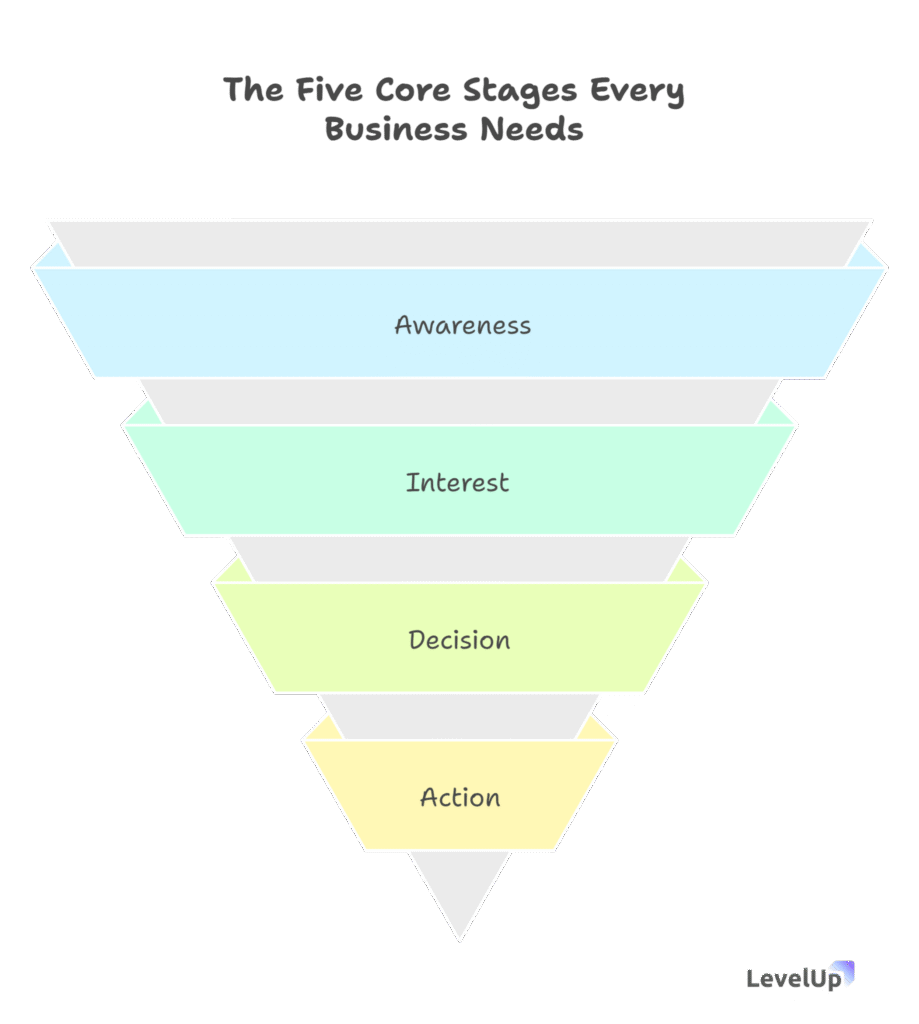
The Anatomy of a High-Converting Sales Funnel
Stage 1: Awareness – Getting on Their Radar
This is where everything starts. People can’t buy from you if they don’t know you exist, right?
I remember working with this consulting firm that was struggling to get new clients. They were amazing at what they did, but nobody knew about them. We focused on creating valuable content that addressed their prospects’ biggest pain points.
- What happens here:
- Prospects discover your business through various channels
- They realize they have a problem you might solve
- They start paying attention to your brand
- Your job at this stage:
- Create helpful, educational content
- Optimize for search engines
- Be active on social media where your customers hang out
- Use paid advertising strategically
- Common mistake I see: Trying to sell immediately. Don’t do this. At the awareness stage, people aren’t ready to buy – they’re just learning about their problem.
Stage 2: Interest/Education – Building the Relationship
Now you’ve got their attention. They’re thinking, “Okay, these people seem to know what they’re talking about.”
This is where you become their trusted advisor, not just another vendor trying to make a sale.
- What happens here:
- Prospects consume your content regularly
- They might sign up for your newsletter or follow your social media
- They’re learning about potential solutions to their problem
- Your job at this stage:
- Provide valuable, educational content
- Build trust through expertise demonstration
- Capture contact information through lead magnets
- Start segmenting your audience based on interests
Stage 3: Consideration/Evaluation – The Comparison Game
This is where prospects get serious about finding a solution. They’re not just browsing anymore – they’re actively evaluating options.
- What happens here:
- Prospects compare different solutions
- They read reviews and case studies
- They might request demos or consultations
- Price becomes a consideration
- Your job at this stage:
- Provide detailed product/service information
- Share customer success stories and testimonials
- Offer free trials, demos, or consultations
- Address common objections proactively
Stage 4: Intent/Negotiation – Closing Time
They want to move forward, but they need to work out the details. This is where your sales skills really come into play.
- What happens here:
- Prospects express serious buying intent
- They want to discuss pricing, terms, and implementation
- They might need approval from others (especially in B2B)
- Objections surface that need addressing
- Your job at this stage:
- Have detailed sales conversations
- Customize proposals based on their specific needs
- Address final objections and concerns
- Make the buying process as smooth as possible
One thing I’ve noticed: the businesses that struggle here usually haven’t done enough work in the earlier stages. If you’ve built trust and demonstrated value properly, closing becomes much easier.
Stage 5: Purchase/Sale – Sealing the Deal
They’re ready to buy. Don’t mess this up with a complicated checkout process or unclear next steps.
- What happens here:
- Final purchase decision is made
- Payment is processed
- Onboarding begins
- Your job at this stage:
- Make purchasing easy and straightforward
- Provide clear next steps
- Begin the onboarding process immediately
- Set expectations for what happens next
But here’s the thing most people miss – the funnel doesn’t end here. What happens after the purchase determines whether they become repeat customers and refer others to you.
Building Your First Sales Funnel: A Step-by-Step Approach
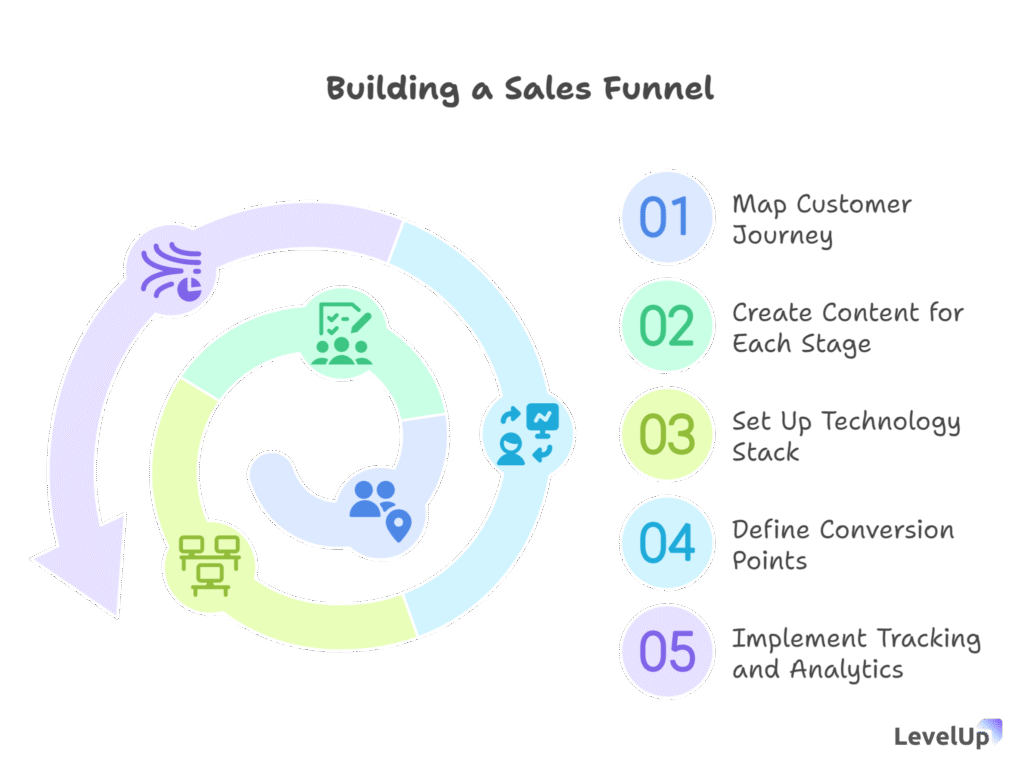
Step 1: Map Your Customer Journey
Before you build anything, you need to understand how your customers actually buy from you.
I always start by interviewing recent customers. I ask questions like:
- How did you first hear about us?
- What made you interested in learning more?
- What other options did you consider?
- What finally convinced you to buy?
- What almost stopped you from buying?
This gives you the real customer journey, not what you think it should be.
Step 2: Create Content for Each Stage
Once you know the journey, create content that helps prospects at each stage.
Awareness stage content:
- Blog posts addressing common problems
- Social media content
- SEO-optimized articles
- Educational videos
Interest stage content:
- Email newsletters
- Detailed guides and whitepapers
- Webinars
- Case studies
Consideration stage content:
- Product demos
- Free trials
- Comparison guides
- Customer testimonials
Intent stage content:
- Detailed proposals
- ROI calculators
- Implementation timelines
- Reference calls with existing customers
Step 3: Set Up Your Technology Stack
You don’t need fancy, expensive tools to start. But you do need some basic systems:
Essential tools:
- A CRM system to track leads (even a simple one like HubSpot’s free version)
- Email marketing platform
- Website with clear calls-to-action
- Analytics to track what’s working
Nice-to-have tools:
- Marketing automation platform
- Landing page builder
- Social media scheduling tools
- Customer support platform
For sales professionals specifically, I’ve seen great results with tools like Levelup demo, which helps manage the demo workflow, qualify leads, schedule demos, and automate follow-ups.
Step 4: Define Your Conversion Points
At each stage, you need clear actions that move prospects to the next level:
- Awareness to Interest: Newsletter signup, content download
- Interest to Consideration: Demo request, consultation booking
- Consideration to Intent: Proposal request, pricing inquiry
- Intent to Purchase: Contract signing, payment processing
Step 5: Implement Tracking and Analytics
You can’t improve what you don’t measure. Track key metrics like:
- Traffic sources
- Conversion rates at each stage
- Time spent in each stage
- Drop-off points
- Customer acquisition cost
- Lifetime value
Common Sales Funnel Mistakes (And How to Avoid Them)
Mistake #1: Trying to Sell Too Early
I see this constantly. Someone signs up for your newsletter, and immediately you’re pitching your product. Don’t do this. Build the relationship first.
Mistake #2: Ignoring the Post-Purchase Experience
The funnel doesn’t end at purchase. Happy customers become repeat buyers and referral sources. Neglecting them is leaving money on the table.
Mistake #3: Making It Too Complicated
Your funnel should be simple and clear. If prospects are confused about what to do next, they’ll do nothing.
Mistake #4: Not Following Up Consistently
Here’s a stat that’ll blow your mind: 80% of sales require 5 follow-up calls after the meeting, but 44% of salespeople give up after one follow-up.
Persistence pays off, but it needs to be valuable persistence, not just pestering.
Mistake #5: Focusing Only on New Customers
It costs 5–25 times more to acquire a new customer than to retain an existing one. Don’t forget about upselling and cross-selling to current customers
.
Advanced Funnel Optimization Strategies
A/B Testing Everything
Test different headlines, email subject lines, call-to-action buttons, landing page designs – everything. Small improvements compound over time.
I worked with one client who increased their conversion rate by 40% just by changing their CTA button from “Submit” to “Get My Free Guide.”
Personalization at Scale
Use the data you collect to personalize the experience. Someone who downloaded your pricing guide should get different follow-up emails than someone who downloaded your beginner’s guide.
Automation That Feels Human
Automation is powerful, but it shouldn’t feel robotic. Write your automated emails like you’re talking to a friend, not broadcasting to a list.
Multi-Channel Integration
Your funnel shouldn’t exist in isolation. Integrate it across all channels – email, social media, your website, even offline interactions.
Industry-Specific Funnel Considerations
Service-Based Businesses
For consultants, agencies, and service providers, the funnel often includes:
- Discovery calls
- Proposal presentations
- Reference checks
- Contract negotiations
The key is building trust and demonstrating expertise throughout the process.
Product-Based Businesses
Physical and digital products might include:
- Product demonstrations
- Free trials or samples
- Customer reviews and ratings
- Easy return policies
B2B vs B2C Differences
B2B funnels are typically longer with more touchpoints and decision-makers involved. B2C funnels can be shorter but need to address emotional triggers more effectively.
Measuring Funnel Performance
Key Metrics to Track
- Conversion Rates: What percentage of people move from one stage to the next?
- Velocity: How long does it take prospects to move through your funnel?
- Volume: How many people are entering your funnel?
- Value: What’s the average deal size and lifetime value?
Setting Up Your Dashboard
Create a simple dashboard that shows:
- Total leads generated
- Conversion rate at each stage
- Average time in each stage
- Revenue generated
- Cost per acquisition
The Future of Sales Funnels
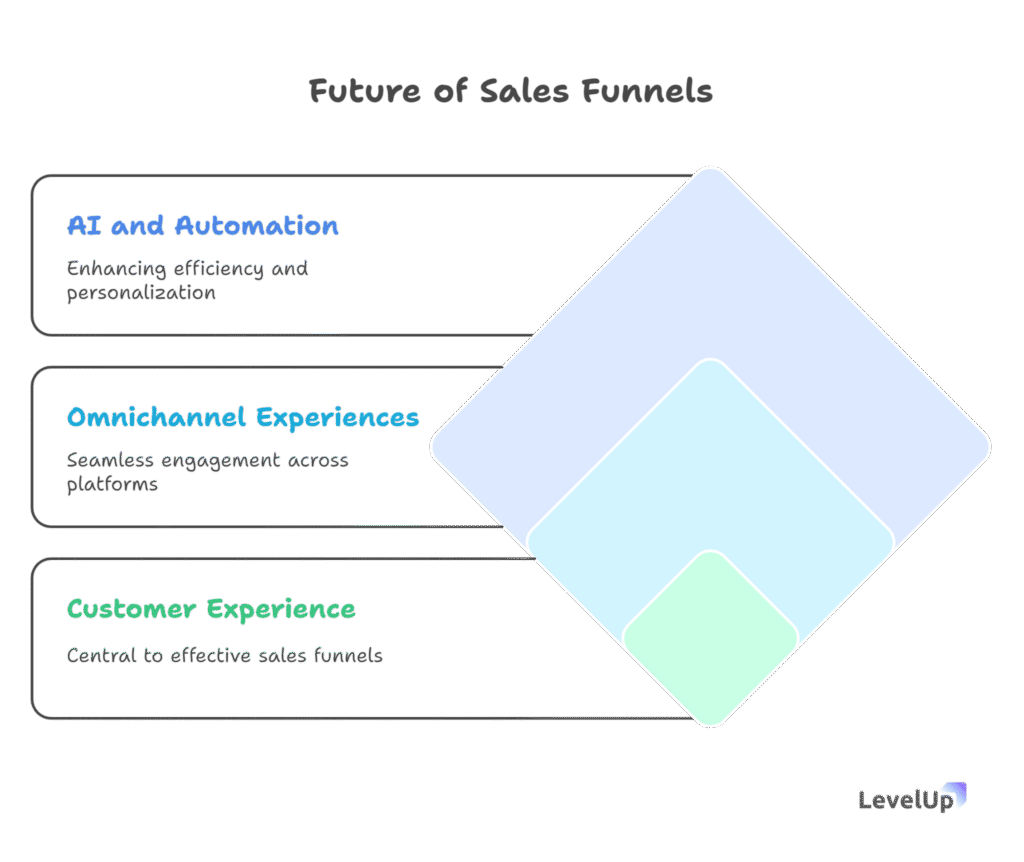
AI and Automation Integration
Artificial intelligence is making funnels smarter. We can now predict which leads are most likely to convert and personalize experiences at scale.
Omnichannel Experiences
Modern funnels span multiple channels seamlessly. A prospect might discover you on social media, engage with your email content, attend a webinar, and finally convert through a phone call.
Focus on Customer Experience
The best funnels don’t feel like funnels – they feel like helpful, natural progressions that solve real problems.
Action Steps and Key Takeaways
Quick Implementation Guide
Week 1: Map Your Current Process
- Interview 5–10 recent customers about their buying journey
- Document the stages they went through
- Identify where prospects typically drop off
Week 2: Create Basic Content
- Write one piece of content for each funnel stage
- Set up basic email sequences
- Create clear calls-to-action
Week 3: Implement Technology
- Choose and set up a simple CRM
- Install analytics tracking
- Create basic landing pages
Week 4: Launch and Test
- Start driving traffic to your funnel
- Monitor conversion rates
- Begin A/B testing different elements
Key Takeaways for Different Experience Levels
If you’re just starting out:
- Keep it simple – focus on the core 5 stages
- Start with basic tools and upgrade as you grow
- Prioritize building trust over making quick sales
If you have some experience:
- Focus on optimization and personalization
- Implement advanced tracking and analytics
- Test different approaches for different customer segments
If you’re advanced:
- Integrate AI and automation tools
- Create sophisticated nurture sequences
- Focus on lifetime value optimization
The Bigger Picture
Remember, a sales funnel isn’t just about making more sales (though it definitely does that). It’s about creating a better experience for your prospects and customers. When done right, your funnel becomes a system that:
- Attracts the right people to your business
- Educates them about their problems and your solutions
- Builds trust and relationships
- Makes the buying process smooth and pleasant
- Creates happy customers who refer others
Whether you’re a sales professional looking to streamline your demo process or an entrepreneur trying to scale your business, implementing a well-designed sales funnel will transform how you approach growth.
Start simple, measure everything, and continuously improve. Your future self (and your bank account) will thank you.
FAQ Section
What is a sales funnel in simple terms?
A sales funnel is basically a step-by-step process that guides potential customers from first hearing about your business to actually buying from you. It’s called a funnel because you start with lots of prospects at the top, and fewer people make it through each stage until you have paying customers at the bottom.
How long should a sales funnel be?
It depends on your business and what you’re selling. Simple products might have short funnels (days or weeks), while complex B2B services might take months. I’ve seen effective funnels range from 3 stages to 10+ stages. The key is matching your funnel to your customer’s actual buying process.
Can small businesses benefit from sales funnels?
Absolutely! In fact, small businesses often see the biggest impact because they’re starting from a less organized place. A simple funnel can dramatically improve your conversion rates and help you compete with larger companies by being more systematic about nurturing leads.
What’s the difference between a sales funnel and a marketing funnel?
A marketing funnel focuses on attracting and engaging prospects (awareness and interest stages). A sales funnel covers the entire journey including the actual selling and closing process. Many businesses use both terms interchangeably, but technically, the sales funnel is broader.
How do I know if my sales funnel is working?
Look at your conversion rates at each stage. If you’re losing too many people between stages, that’s where you need to focus. Also track metrics like time to close, customer acquisition cost, and lifetime value. If these are improving over time, your funnel is working.
What tools do I need to create a sales funnel?
You can start simple with just a CRM system and email marketing platform. As you grow, you might add marketing automation, landing page builders, and analytics tools. For sales professionals managing demos, tools like Levelup demo can streamline the process significantly.
How often should I update my sales funnel?
I recommend reviewing your funnel quarterly and making small adjustments monthly. Major overhauls should only happen when you see significant changes in customer behavior or when you’re launching new products/services.
Can I have multiple sales funnels?
Yes, and you probably should! Different customer segments often need different approaches. You might have one funnel for small businesses and another for enterprise clients, or separate funnels for different product lines.
What’s the biggest mistake people make with sales funnels?
Trying to sell too early. Most people jump straight to pitching their product instead of building trust and providing value first. Remember, people buy from businesses they know, like, and trust.
How do I get people into my sales funnel?
Focus on creating valuable content that addresses your prospects’ problems. Use SEO, social media, paid advertising, networking, and referrals to drive traffic to your content. The key is offering something valuable in exchange for their contact information.
